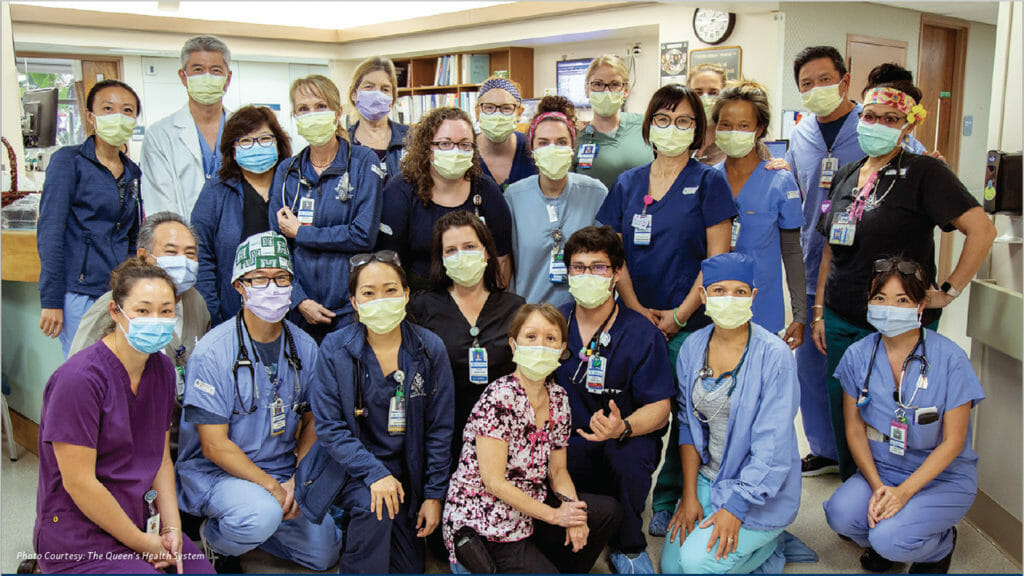
What difference can three years and a once-in-a-century pandemic make to Hawaii’s healthcare workforce?
A lot, according to the 2022 Healthcare Workforce Initiative report assessing healthcare staffing and education needs in the Aloha State. The report is a follow-up to the inaugural 2019 report, launched by the Healthcare Association of Hawaii, which represents assisted living and skilled nursing facilities, home care companies, hospices and hospitals.
Among the key findings is the need to increase entry-level health certification pipeline, attract and retain healthcare workforce through glide paths, and expand nurse residency and transition-to-specialty registered nurse programs.
Recognizing a growing need for more healthcare workers, HAH in 2018 launched the Healthcare Workforce Initiative to better understand the current employment needs across the state’s healthcare continuum. The collaboration across the state’s education, healthcare and community-based sectors shares a common goal of increasing locally trained and educated healthcare employees, according to HAH President and CEO Hilton R. Raethel.
A growing need for healthcare workers
The 2022 report identified almost 3,900 open positions across 89 public-facing professions, a 76% increase over 2019 figures. Respondents included assisted living communities and other long-term care settings, hospitals, health system clinics, physician officers, federally qualified health centers, physical therapy providers and health insurers.
In assisted living, the overall healthcare vacancy rate moved from 11% in 2019 to 14% this year. Entry-level open certified nursing assistant positions remain elevated in 2022, with a 15% vacancy rate, whereas the vacancy rate for licensed practice nurses is 32%, according to Hilton. O’ahu has the highest number of open assisted living positions among all the islands.
Overall, across all settings, 17% of positions remain unfilled for healthcare organizations surveyed — up from 10% in 2019. By profession, compared with 2019, there was a 78% increase in the number of CNA openings across all providers surveyed, a 47% increase among LPN openings, a 417% increase among personal care assistant openings, and a 116% increase among RN open positions.
Hilton told McKnight’s Senior Living that among the reasons driving openings are burnout, retirements and the net outward migration of working adults due to the high cost of living in Hawaii, as well as a net inward migration of older adults needing services.
“That means we need more people in our healthcare workforce,” he said.
Wesley Lo, CEO of Ohana Pacific Health and Hale Makua, told McKnight’s Senior Living that assisted living communities and nursing homes can’t compete for RNs from a reimbursement standpoint, so attention turned to increasing LPN programs across the state.
“The industry is now realizing we need to work together,” Lo said. “Employers need to take positions in the development of people. They can’t just rely on the education system.”
At the core of the Healthcare Workforce Initiative, Hilton said, is education and employers working together “to better match supply and demand and make sure we pivot and adjust over time.”
Moving the needle one program at a time
Collaborative partnerships have yielded some successes, including a partnership between HAH and the University of Hawaii Community College system to create an entry-level certification pipeline for CNAs and other healthcare positions. To date, more than 28 cohorts and 250 students have completed health certificate training programs, with an 80% employment rate.
In 2021, HAH convened the Collaborative LPN Innovation Team to design an LPN pilot program to train employed CNAs to become LPNs. The program prioritizes admissions for working CNAs and enables the earn-and-learn — or glide path — approach through an online curriculum and clinical education at the current workplace. The program will launch in 2023.
Another new program coming next year is a pilot of a high school healthcare certificate program for students in underrepresented public schools. The effort will focus on the transition-to-employment model by offering career exploration, mentoring and employment opportunities.
“We’re still behind the curve because of the pandemic, which exacerbated the workforce shortage,” Hilton said. “We’ve got a lot of work to do, but we know what we need to do and where we need to invest over the next few years. I’m hopeful about the future.”
HAH plans to conduct surveys every two years. Access to the 2022 Healthcare Workforce Initiative Report is available on the HAH website.




